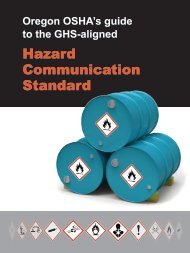Technical Manual - Section 3 (Safety Hazards)
Technical Manual - Section 3 (Safety Hazards)
Technical Manual - Section 3 (Safety Hazards)
You also want an ePaper? Increase the reach of your titles
YUMPU automatically turns print PDFs into web optimized ePapers that Google loves.
LIQUID PENETRANT TEST (PT)<br />
This method depends on allowing a specially formulated<br />
liquid (penetrant) to seep into an open discontinuity and then<br />
detecting the entrapped liquid by a developing agent. When<br />
the penetrant is removed from the surface, some of it remains<br />
entrapped in the discontinuities. Application of a developer<br />
draws out the entrapped penetrant and magnifies the<br />
discontinuity. Chemicals which fluoresce under black<br />
(ultraviolet) light can be added to the penetrant to aid the<br />
detectability and visibility of the developed indications. The<br />
essential feature of PT is that the discontinuity must be<br />
"open," which means a clean, undisturbed surface.<br />
The PT method is independent of the type and composition<br />
of the metal alloy so it can be used for the examination of<br />
austenitic stainless steels and nonferrous alloys where the<br />
magnetic particle test is not applicable.<br />
MAGNETIC PARTICLE TEST (MT)<br />
This method depends on the fact that discontinuities in or<br />
near the surface perturb magnetic flux lines induced into a<br />
ferromagnetic material. For a component such as a pressure<br />
vessel where access is generally limited to one surface at a<br />
time, the "prod" technique is widely used. The magnetic field<br />
is produced in the region around and between the prods<br />
(contact probes) by an electric current (either AC or DC)<br />
flowing between the prods. The ferromagnetic material<br />
requirement basically limits the applicability of MT to carbon<br />
and low- alloy steels.<br />
The perturbations of the magnetic lines are revealed by<br />
applying fine particles of a ferromagnetic material to the<br />
surface. The particles can be either a dry powder or a wet<br />
suspension in a liquid. The particles can also be treated to<br />
fluoresce under black light. These options lead to variations<br />
such as the "wet fluorescent magnetic particle test" (WFMT).<br />
MT has some capability for detecting subsurface defects.<br />
However, there is no easy way to determine the limiting depth<br />
of sensitivity since it is highly dependent on magnetizing<br />
current, material, and geometry and size of the defect. A very<br />
crude approximation would be a depth no more than 1.5 mm<br />
to 3 mm (1/16 in to 1/8 in).<br />
A very important precaution in performing MT is that corners<br />
and surface irregularities also perturb the magnetic field.<br />
Therefore, examining for defects in corners and near or in<br />
welds must be performed with extra care. Another precaution<br />
is that MT is most sensitive to discontinuities which are<br />
oriented transverse to the magnetic flux lines and this<br />
characteristic needs to be taken into account in determining<br />
the procedure for inducing the magnetic field.<br />
RADIOGRAPHY (RT)<br />
The basic principle of radiographic examination of metallic<br />
objects is the same as in any other form of radiography such<br />
as medical radiography. Holes, voids, and discontinuities<br />
decrease the attenuation of the X-ray and produce greater<br />
exposure on the film (darker areas on the negative film).<br />
Because RT depends on density differences, cracks with<br />
tightly closed surfaces are much more difficult to detect than<br />
open voids. Also, defects located in an area of a abrupt<br />
dimensional change are difficult to detect due to the<br />
superimposed density difference. RT is effective in showing<br />
defect dimensions on a plane normal to the beam direction<br />
but determination of the depth dimension and location<br />
requires specialized techniques.<br />
Since ionizing radiation is involved, field application of RT<br />
requires careful implementation to prevent health hazards.<br />
ULTRASONIC TESTING (UT)<br />
The fundamental principles of ultrasonic testing of metallic<br />
materials are similar to radar and related methods of using<br />
electromagnetic and acoustic waves for detection of foreign<br />
objects. The distinctive aspect of UT for the inspection of<br />
III:3-7
















